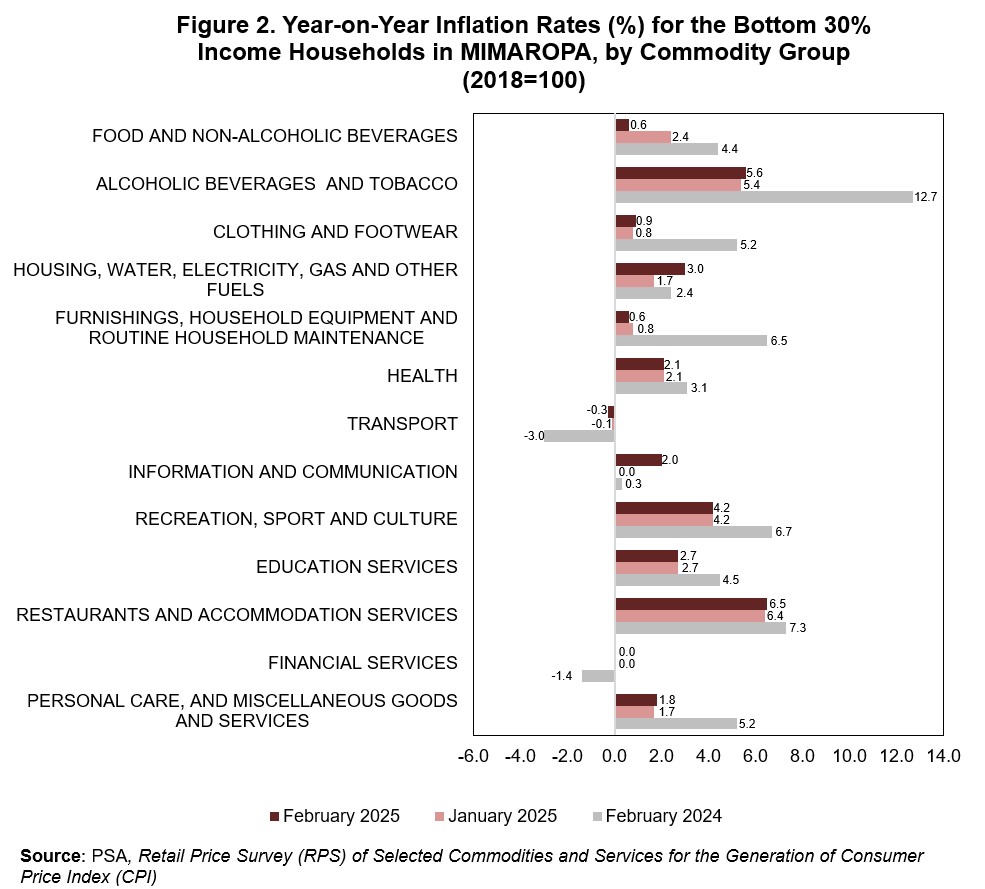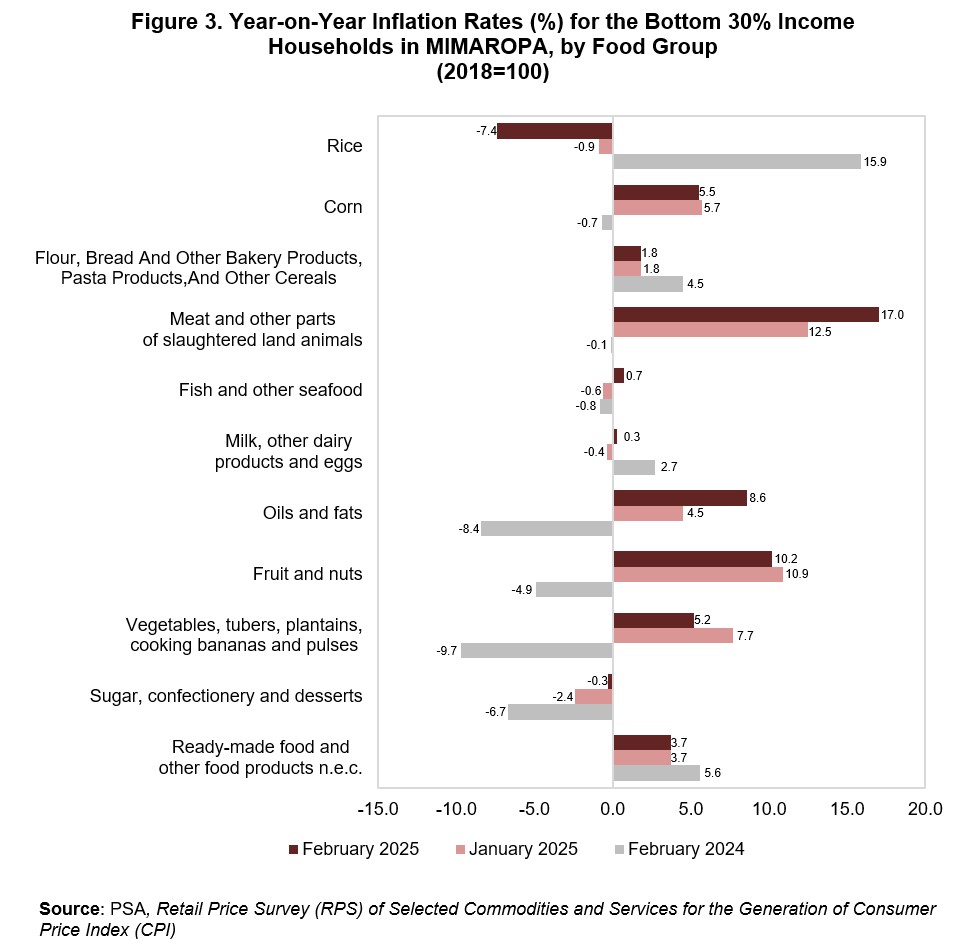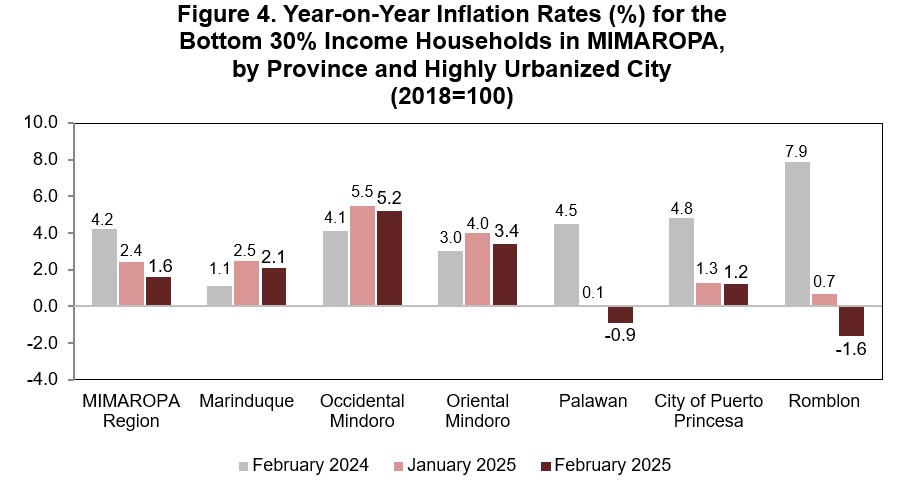
The inflation rate at the regional level, for the bottom 30 percent income households decelerated to 1.6 percent in February 2025 or a 0.8 percentage point decrease from January 2025 inflation. The index was recorded at 4.2 percent in the same reference month of the previous year. The main contributors to the downtrend of inflation were food and non-alcoholic beverages (0.6 percent inflation), transport (-0.3 percent inflation), and furnishing, household equipment and routine household maintenance (0.6 percent inflation).
INFLATION RATE BY COMMODITY GROUP

On the other hand, the commodity groups which recorded a higher annual increment in February 2025 were the following: restaurants and accommodation services (6.5% inflation), alcoholic beverages and tobacco (5.6% inflation), housing, water, electricity, gas and other fuel (3.0% inflation), information and communication (2.0% inflation), personal care, and miscellaneous goods and services (1.8% inflation), and clothing and footwear (0.8% inflation).
Meanwhile, health (2.1% inflation), recreation, sport and culture (4.2% inflation), education services (2.7% inflation), and financial services (0.0% inflation) retained their previous month’s inflation rate.
INFLATION RATE BY FOOD GROUP

The region’s food index further decelerated to 0.6 percent in February 2025, from 2.4 percent in the previous month, and 4.3 percent in February 2024. Moreover, the downtrend in food inflation were contributed by rice (-7.4 percent inflation), corn (5.5% inflation), fruits and nuts (10.2% inflation), and vegetables, tubers, plantains, cooking bananas and pulses (5.2% inflation).
On the other hand, the following food groups posted higher annual indices in February 2025:
• Meat and other parts of slaughtered land animal (17.0% inflation)
• Oils and fats (8.6% inflation)
• Fish and Other seafoods (0.7% inflation),
• Milk, other dairy products and eggs (0.3 % inflation), and
• Sugar, confectionary and desserts (-0.3%) inflation
Meanwhile, the flour, bread and other bakery products, pasta products and other cereals (1.8% inflation) and ready-made food and other food products (3.7% inflation) retained their previous month’s inflation rate.
INFLATION RATE BY PROVINCE

Among the provinces and highly urbanized city in the region, Occidental Mindoro had the highest inflation for the bottom 30 percent income households, with 5.2 percent, while Romblon posted the lowest with -1.6 percent.
The provinces of Marinduque, Occidental Mindoro, Oriental Mindoro, and the City of Puerto Princesa showed an ease in their inflation. Meanwhile, the average price of goods and services for the bottom 30 percent income households in the province of Palawan recorded a 0.1 percent inflation in February 2025, from the -0.1 percent inflation in the previous month.
TECHNICAL NOTES
• Consumer Price Index is an indicator of the change in the average prices of a fixed basket of goods and services commonly purchased by households relative to a base year.
• Market Basket is a sample of goods and services, which is meant to represent the totality of all the goods and services purchased by households relative to a base year.
o To determine the commodities that will form the market basket for the 2018-based CPI, the Survey of Key Informants (SKI) was conducted in April 2021. The survey, which was conducted nationwide to store managers, sellers or proprietors, obtained information on the most commonly purchased of goods and availed of services by the households.
o The commodities in the 2018-based CPI market basket are grouped/classified according to the 2020 Philippine Classification of Individual Consumption According to Purpose (PCOICOP) which is based on the United Nations COICOP. Meanwhile, the commodities in the 2012-based CPI market basket used the 2009 PCOICOP version of classification of commodities.
• Base year is a reference period, usually a year, at which the index number is set to 100. It is the reference point of the index number series. The CPI is rebased from base year 2012 to base year 2018.
• Inflation Rate is the annual rate of change or the year-on-year change in the Consumer Price Index (CPI).
• Purchasing Power of Peso is a measure of the real value of the peso in a given period relative to a chosen reference period. It is computed by getting the reciprocal of the CPI and multiplying the result by 100.
Inflation Rate (reference month, reference year)
= [(CPI (reference month, reference year) - CPI (reference month, previous year)) / CPI (reference month, previous year)] x 100%
For example,
INFLATION RATE (February 2025) = [(CPI (February 2025) - CPI (February 2024)) /
CPI (February 2024)] x 100%
= [(134.4 – 132.3) / 132.3] x 100%
= (2.1 / 132.3) x 100%
≈ 1.6%
(SGD) LENI R. RIOFLORIDO
Regional Director
MLLM / OHG / APAR / MCCM

